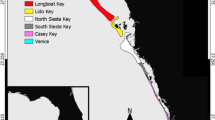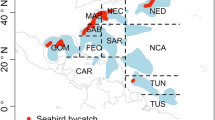Abstract
The purpose of this study was to design and test a monitoring protocol for marine waterfowl in the central Alaskan Beaufort Sea. The study provides an important case-study of how a long-term monitoring program may be affected by unanticipated human disturbances.
Because of its overwhelming and widespread abundance, relatively sedentary behavior, ease in counting, and the extensive historical database, the long-tailed duck (Clangula hyemalis) was selected as the focal species. Two null hypotheses were formulated concerning potential changes in the numbers and distribution of long-tailed ducks in relation to disturbance in an industrial study area, compared to a reference study area located about 50 km to the east.
A 9-year historical database (1977–1984, 1989) of long-tailed duck densities and other important data recorded during systematic aerial surveys was analyzed retrospectively using multiple regression techniques. The retrospective analyses determined which of several predictor variables recorded were significantly related to long-tailed duck density. Separate analyses were conducted for two periods: (1) the overall period when long-tailed ducks were present in the lagoon study areas, and (2) the shorter adult male molt period. The results of the two analyses indicated that 57% and 68%, respectively, of the total variation in long-tailed duck density during the two periods could be explained by variables recorded during the surveys. Predictor variables representing habitat, day of the year, time of day, amount of ice, and wave height recorded on-transect during surveys were most closely associated with long-tailed duck density. Measurement error during the surveys, and influences outside the study area such as nesting success in tundra habitats and mortality during migration and in over-wintering areas likely also had strong influences on the results, but these factors were not measurable in our study.
Based on results of the retrospective analyses, a long-term monitoring protocol consisting of a program of systematic aerial surveys and an analyses of variance and covariance (ANOVA and ANCOVA) statistical procedure was designed and initially tested in 1990 and 1991. This 2-year testing phase resulted in several revisions to the monitoring protocol. Refinements were made to the original sampling procedures, to the survey schedule, and to the recommended statistical analysis procedures. Results of the ANOVA and ANCOVA indicated that there was no evidence of a change in long-tailed duck densities that could be attributable to disturbance (from any source) in the industrial study area relative to a reference area with no industrial development. Other analyses indicated that the sampling and analysis procedures would be adequate to detect long-term trends in long-tailed duck density and localized disturbance effects, but that the monitoring program should be continued well beyond two years to detect statistically significant changes. As a result, additional aerial surveys of both study areas were conducted again during 1999–2001.
Results of the revised ANOVA and ANCOVA of the 1990–1991 and 1999–2001 survey data indicated that the density of long-tailed ducks had significantly declined in coastal lagoons along the central Alaskan Beaufort Sea coast during the study period. In addition, disturbances throughout the barrier island-lagoon systems used by these ducks, including both the industrial and the reference study areas, had significantly increased over the same period. However, because unanticipated disturbances from a variety of anthropogenic sources, and not just industry sources, increased in both study areas, the reference study area was not an effective statistical control. As a result, the decline in long-tailed duck density in both study areas was not attributable to industry-related activities. Although the monitoring protocol described here is an effective method to detect statistically significant changes in long-tailed duck distribution and abundance in the nearshore Alaskan Beaufort Sea, many more years of sampling would be necessary to attribute observed changes to industry-related disturbances.
Similar content being viewed by others
References
Bartels, R. F., Doyle, T. J. and Wilmers, T. J.: 1984, ‘Movement of Molting Oldsquaw Within the Beaufort Sea Coastal Lagoons of the Arctic National Wildlife Refuge, Alaska’, in: G. W. Garner and P. E. Reynolds (eds.), 1983 Update Report, Baseline Study of the Fish, Wildlife, and Their Habitats, by U. S. Fish and Wildlife Service, Arctic National Wildlife Refuge, Fairbanks, Alaska, 379 p.
Bliss, C. I.: 1970, Statistics in Biology, Statistical Methods for Research in the Natural Sciences, Vol. 2. McGraw-Hill, New York.
Brackney, A. W. and King, R. J.: 1991, Aerial Breeding Pair Surveys of the Arctic Coastal Plain of Alaska: Abundance and Distribution of Waterbirds, 1986–1990’, Report by U.S. Fish and Wildlife Service, Office of Migratory Bird Management, Fairbanks, Alaska, 6 p.
Brackney, A. W., Morton, J. W., Noll, J. M. and Masteller, M. A.: 1985, ‘Movements of Molting Long-Tailed Ducks within the Beaufort Sea Coastal Lagoons of the Arctic National Wildlife Refuge, Alaska, 1984’, in: 1984 Update Report, Baseline Study of the Fish, Wildlife, and Their Habitats, by U.S. Fish and Wildlife Service, Arctic National Wildlife Refuge, Fairbanks, Alaska.
Brower, W. A. Jr., Searby, H. W., Wise, J. L., Diaz, H. F. and Prechtel, A. S.: 1977, Climatic Atlas of the Outer Continental Shelf Waters and Coastal Regions of Alaska, Vol. 3, Chukchi-Beaufort Sea, Bureau of Land Management/National Oceanic and Atmospheric Administration, Outer Continental Shelf Environmental Assessment Program. Anchorage, Alaska.
Burdick, R. K. and Graybill, F. A.: 1992, Confidence Intervals on Variance Components, Marcel Dekker, New York.
Craig, P. C., Griffiths, W. B., Johnson, S. R. and Schell, D. M.: 1984, ‘Trophic Dynamics in an Arctic Lagoon’, in: P. Barnes, E. Reimnitz, and D. Schell (eds), Alaskan Beaufort Sea Ecosystems and Environment, Academic Press, New York.
Dames and Moore.: 1984, Beaufort Sea Monitoring Program Workshop Synthesis and Sampling Design Recommendations, Report by Dames and Moore Inc., Anchorage, Alaska, for U.S. Department of Commerce, National Oceanic and Atmospheric Administration, Juneau, Alaska.
Dickson, D. L. and Gilchrist, H. G.: 2002, ‘Status of marine birds in the southeastern Beaufort Sea’, Arctic 55 (Suppl 1), 46–58.
Draper, N. R. and Smith, H.: 1981, Applied Regression Analysis, 2nd edn., Wiley, New York.
Fischer, J. B., Tiplady, T. J. and Larned, W. W.: 2002, Monitoring Beaufort Sea Waterfowl and Marine Birds, Aerial Survey Component, Report MMS 2002-002 by U.S. Fish and Wildlife Service, Migratory Bird Management, Anchorage, Alaska, for U.S. Minerals Management Service, Anchorage, Alaska, 136 p.
Flint, P. A., Lanctot, R. B., Fischer, J. B., Franson, J. C., Hollmén, T., Grand, J. B. and Howell, M.: 2000, Monitoring Beaufort Sea Waterfowl and Marine Birds, Report by U.S. Geological Survey, Anchorage, Alaska, for U.S. Minerals Management Service, Anchorage, Alaska, 43 p.
Gallaway, B. J. and Fechhelm, R. G.: 2000, ‘Anadromous and amphidromous fishes’, in: J. C. Truett and S. R. Johnson (eds.), The Natural History of an Arctic Oil Field: Development and the Biota, Academic Press, New York.
Green, R. H.: 1979, Sampling Design and Statistical Methods for Environmental Biologists, Wiley, New York.
Hochbaum, H. A.: 1955, Travels and Traditions of Waterfowl, University of Minnesota Press, Minneapolis, Minnesota.
Hollmén, T. E., Franson, J. C., Flint, P. L., Grand, J. B., Lanctot, R. B., Docherty, D. E. and Wilson, H. M.: 2002, ‘Adenovirus –A Cause of Mortalilty in Long-tailed Ducks (Clangula hyemalis) in Alaska?’ in: Proceedings of the 2002 NA Sea Duck Conference and Workshop, Victoria, British Columbia, p. 31.
Huitema, B. E.: 1980, The Analysis of Covariance and Alternatives, Wiley, New York.
Johnson, S. R.: 1982, ‘Continuing Investigations of Oldsquaws (Clangula hyemalis L.) During the Molt Period in the Alaskan Beaufort Sea’, in: Environmental Assessment of the Alaskan Continental Shelf, Final Reports of Principal Investigators, Vol. 23, Report by LGL Alaska Research Associates Inc., Fairbanks, Alaska, for Bureau of Land Management and National Oceanic and Atmospheric Administration, Outer Continental Shelf Environmental Assessment Program. Juneau, Alaska. NTIS PB85-212595/AS.
Johnson, S. R.: 1984a, ‘Prey Selection by Oldsquaws (Clangula hyemalis L.) in a Beaufort Sea Lagoon’, in: D. N. Nettleship, G. A. Sanger, and P. F. Springer (eds.), Marine Birds: Their Feeding Ecology and Commercial Fisheries Relationships, Proc. Pacific Seabird Group Symp., Seattle, Washington, 1982, Canadian Wildlife Service Special Publication, Ottawa, Canada.
Johnson, S. R.: 1984b, Habitat Use and Behavior of Nesting Common Eiders and Molting Oldsquaws at Thetis Island, Alaska, During a Period of Industrial Activity, report by LGL Alaska Research Associates Inc., Anchorage, Alaska, for Sohio Alaska Petroleum Co., Anchorage, Alaska.
Johnson, S. R.: 1985, ‘Adaptations of the Long-tailed duck (Clangula hyemalis L.). During the period of molt in Arctic Alaska’, Proc. Int. Ornith. Congress 18(1): 530–540.
Johnson, S. R.: 1990, Monitoring Beaufort Sea Waterfowl and Marine Birds, Report MMS 90-0048 by LGL Alaska Research Associates Inc., Anchorage, Alaska, for U.S. Minerals Management Service, Anchorage, Alaska, 121 p.
Johnson, S. R. and Gazey, W. J.: 1992, Design and Testing of a Monitoring Program for Beaufort Sea Waterfowl and Marine Birds, Report MMS 92-0060 by LGL Limited, Sidney, British Columbia, for U.S. Department of Interior, Minerals Management Service, Anchorage, Alaska, 114 p.
Johnson, S. R. and Herter, D. R.: 1989, The Birds of the Beaufort Sea, BP Exploration, Anchorage, Alaska.
Johnson, S. R. and Richardson, W. J.: 1981, ‘Barrier Island Lagoon Ecological Process Studies, Simpson Lagoon: Birds’, in: Environmental Assessment of The Alaskan Continental Shelf, Final Report of Principal Investigators, Vol. 7, Report by LGL Limited, Sidney, British Columbia, for Bureau of Land Management and National Oceanic and Atmospheric Administration, Outer Continental Shelf Environmental Assessment Program, Boulder, Colorado. NTIS PB82-192113/AS.
Johnson, S. R. and Richardson, W. J.: 1982, ‘Waterbird migration near the Yukon and Alaskan coast of the Beaufort Sea. II. Moult migration of seaducks’, Arctic 35, 291–301.
King, R. J.: 1991, ‘1991 Breeding Pair Survey of the Arctic Coastal Plain’, Report by U.S. Fish and Wildlife Service, Office of Migratory Bird Management, Fairbanks, Alaska.
Lanctot, R. B., Reed, J., Lacroix, D., Flint, F., Franson, J. C., Hollmén, T., Howell, M. D. and Grand, J. B.: 2001, ‘Monitoring Beaufort Sea waterfowl and marine birds, 2001’, Report by U.S. Geological Survey, Anchorage, Alaska, for U.S. Minerals Management Service, Anchorage, Alaska, 70 p.
Lokemoen, J. T., Duebbert, H. F. and Sharp, D. E.: 1990, ‘Homing and reproductive habits of mallards, Gadwalls, and Blue-Winged Teal’, Wildife. Monogr. 106, 1–28.
Mallek, E. J., Platte, R. and Stehn, R.: 2002, ‘Aerial Breeding Pair Surveys of the Arctic Coastal Plain of Alaska –2001’, Report by U.S. Fish and Wildlife Service, Office of Migratory Bird Management, Anchorage, Alaska, 25 p.
Milliken, G. A. and Johnson, D. E.: 1984, Analysis of Messy Data, Vol. 1: Designed experiments, Van Nostrand-Reinhold, New York.
Milliken, G. A. and Johnson, D. E.: 2002, Analysis of Messy Data, Vol III: Analysis of Covariance, Chapman and Hall, New York.
Noel, L. E., O’Doherty, G. M. and Johnson, S. R.: 2002, ‘Aerial Surveys of Molting Waterfowl in the Barrier Island-Lagoon Systems Between Spy Island and Brownlow Point, Alaska, 2002’, Report by LGL Alaska Research Associates Inc., Anchorage, Alaska, and LGL Limited, Sidney, British Columbia, for BP Exploration (Alaska) Inc., Anchorage, Alaska, 105 p.
Petersen, M. R., Flint, P. L., Larned, W. W. and Grand, J. B.: 1999, ‘Monitoring Beaufort Sea Waterfowl and Marine Birds’, Report by U.S. Geological Survey, Anchorage, Alaska, for U.S. Minerals Management Service, Anchorage, Alaska, 33 p.
Robertson, G. J. and Savard, J.-P. L.: 2002, ‘Long-Tailed Duck (Clangula hyemalis),’ in: A. Poole and F. Gill (eds.), The Birds of North America, No. 651, The Birds of North America, Inc., Philadelphia, Pennsylyania.
Underwood, A. J.: 1991, ‘Beyond BACI: Experimental designs for detecting human environmental impacts on temporal variations in natural populations’, Aust. J. Mar Fresh. Res. 42, 569–587.
Wilkinson, L.: 1987, SYSTAT: The System for Statistics, SYSTAT, Inc., Evanston, Illinois.
Winer, B. J.: 1971, Statistical Principles in Experimental Design, 2nd edn., McGraw-Hill, New York.
Winer, B. J., Brown, D. R. and Michels, K. M.: 1991, Statistical Principles in Experimental Design, 3rd edn., McGraw Hill, New York.
Author information
Authors and Affiliations
Corresponding author
Rights and permissions
About this article
Cite this article
Johnson, S.R., Noel, L.E., Gazey, W.J. et al. Aerial Monitoring of Marine Waterfowl in the Alaskan Beaufort Sea. Environ Monit Assess 108, 1–43 (2005). https://doi.org/10.1007/s10661-005-3958-5
Received:
Accepted:
Issue Date:
DOI: https://doi.org/10.1007/s10661-005-3958-5




